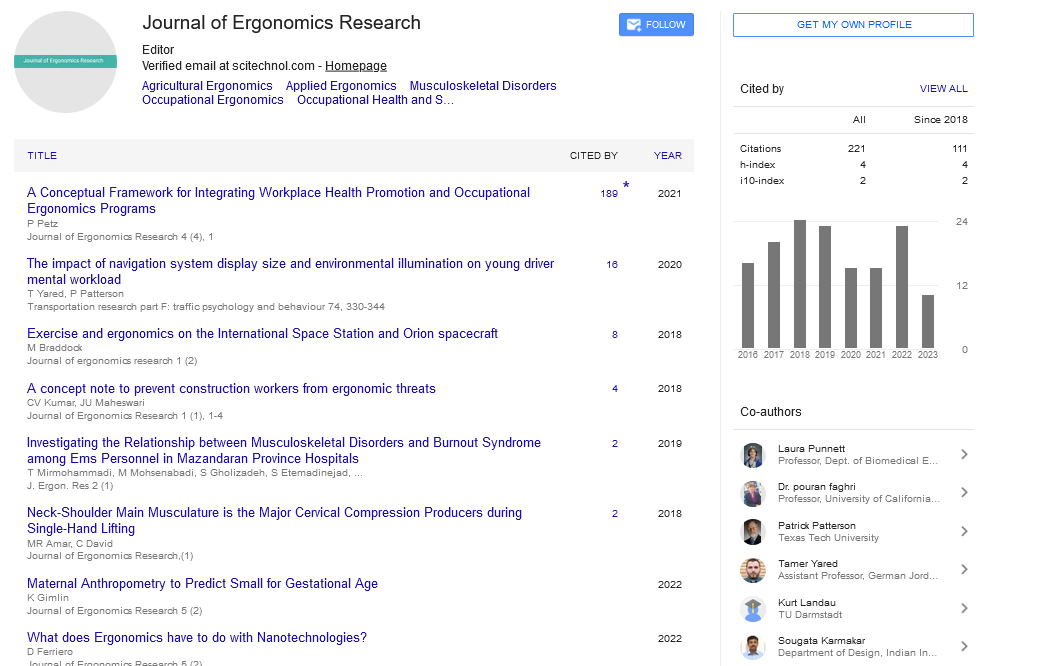Perspective, J Ergon Res Vol: 6 Issue: 3
Ergonomics and Work-Related Musculoskeletal Disorders in the Age of Telecommuting
Justin Gary*
1Department of Ergonomics, Concordia University, Quebec, Canada
*Corresponding Author: Justin Gary,
Department of Ergonomics, Concordia
University, Quebec, Canada
E-mail: garyjustin@gamil.com
Received date: 30 August, 2023, Manuscript No. JEOR-23-117745;
Editor assigned date: 01 September, 2023, PreQC No. JEOR-23-117745 (PQ);
Reviewed date: 15 September, 2023, QC No. JEOR-23-117745;
Revised date: 22 September, 2023, Manuscript No. JEOR-23-117745 (R);
Published date: 29 September, 2023 DOI: 10.4172/jeor.1000137.
Citation: Gary J (2023) Ergonomics and Work-Related Musculoskeletal Disorders in the Age of Telecommuting. J Ergon Res 6:3.
Description
The rise of telecommuting, accelerated by global events such as the COVID-19 pandemic, has brought about a fundamental change in how and where we work. As remote work becomes a significant part of the employment landscape, it is essential to address the growing concern of work-related Musculoskeletal Disorders (MSDs) in this context. This 700-word exploration delves into the importance of ergonomics in the age of telecommuting, its impact on employee health, and strategies for preventing and managing work-related MSDs. Musculoskeletal disorders, commonly referred to as MSDs, encompass a range of conditions affecting the muscles, tendons, ligaments, joints, and other parts of the musculoskeletal system. These disorders often result from repetitive movements, awkward postures, and excessive force, which can strain or damage the musculoskeletal structures. Common MSDs include conditions like carpal tunnel syndrome, tendinitis, and lower back pain. MSDs are a prevalent occupational health issue, causing discomfort, pain, and functional impairment. They can have a significant impact on work performance, absenteeism, and overall well-being. The shift to telecommuting has introduced new challenges in preventing and managing these disorders.
Ergonomics, also known as human factors engineering, focuses on designing workspaces and tasks to fit the capabilities and limitations of the human body. It aims to optimize the efficiency, safety, and comfort of work environments, minimizing the risk of work-related injuries, including MSDs. In the context of telecommuting, ergonomics is paramount. The absence of a traditional office setting means that employees must take greater responsibility for their own workspaces. Without proper ergonomics, remote workers may experience a wide range of health issues, including eyestrain, back pain, carpal tunnel syndrome, and more.
Suboptimal Workstations: Many remote workers lack access to fully equipped offices, leading to suboptimal workstations. Kitchen tables and sofas often serve as makeshift desks, resulting in poor posture and strain on the neck, back, and wrists. Extended Screen Time: Telecommuting typically involves increased screen time for activities like video meetings, emailing, and data entry. Prolonged screen exposure can lead to eyestrain and conditions like digital eye strain or computer vision syndrome.
Sedentary lifestyle: The absence of a daily commute and traditional office activities can result in a more sedentary lifestyle for remote workers. Prolonged sitting, combined with poor ergonomics, increases the risk of lower back pain, obesity, and cardiovascular issues.
Lack of physical activity: The convenience of remote work can sometimes lead to a lack of physical activity. An active workplace environment can reduce the risk of MSDs by promoting blood circulation and muscle engagement.
Social isolation: The isolation of remote work can affect mental health, leading to stress and tension that may exacerbate MSD symptoms.
Preventing and managing MSDS in telecommuting
Ergonomic workspace design: Remote workers should create ergonomic workstations with proper seating, adjustable desks, and appropriate monitor placement. Ergonomic accessories such as chairs with lumbar support, adjustable keyboard trays, and monitor stands can be valuable investments.
Frequent breaks: Encourage remote workers to take regular breaks. Microbreaks, where employees briefly stand, stretch, and move around, can help alleviate the strain of prolonged sitting.
Exercise and stretching: Remote workers should incorporate physical activity and stretching into their daily routines. Simple exercises and stretches can help prevent and manage MSDs.
Eye care: To combat digital eye strain, advise remote workers to follow the 20-20-20 rule: every 20 minutes, take a 20-second break, and look at something 20 feet away.
Support and education: Employers should provide support and educational resources to remote workers. This can include training on ergonomics, remote work policies, and guidance on physical and mental health.
Telehealth services: Telecommuting employees can benefit from telehealth services, which can provide remote consultations with healthcare professionals for managing MSD symptoms.
Mental health support: Addressing the social isolation and mental health aspects of telecommuting is crucial. Regular communication, team-building activities, and access to mental health resources can help remote workers maintain well-being. While telecommuting may have started as a response to the pandemic, it is likely to remain a prominent feature of the modern work landscape. To ensure the longterm health and productivity of remote workers, organizations must prioritize ergonomics and the prevention of work-related MSDs. It is essential for both employers and employees to recognize the importance of creating ergonomic workspaces, maintaining a balance between work and breaks, staying physically active, and taking care of their mental well-being.
In conclusion, telecommuting, a defining feature of the modern workforce, brings both benefits and challenges. As we adapt to this new way of working, ensuring that ergonomics and the prevention of work-related MSDs are integrated into remote work practices is crucial for the health and productivity of employees. Whether working from a traditional office or a home office, prioritizing the well-being of the workforce is an essential component of a successful and sustainable work environment.
 Spanish
Spanish  Chinese
Chinese  Russian
Russian  German
German  French
French  Japanese
Japanese  Portuguese
Portuguese  Hindi
Hindi 